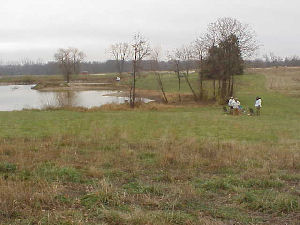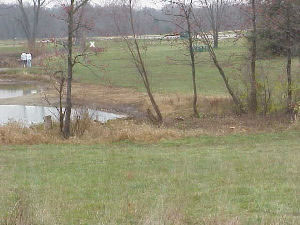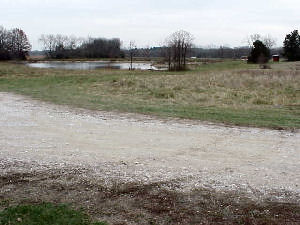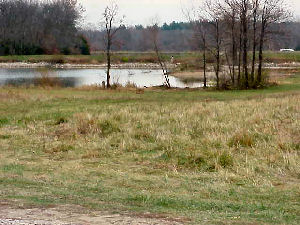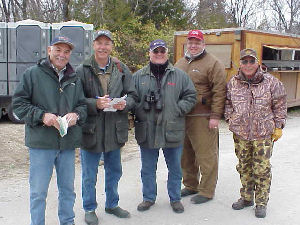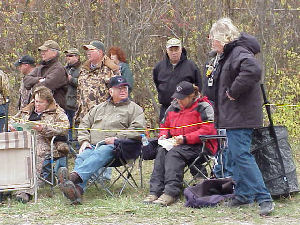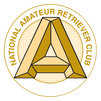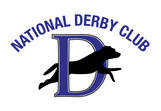Friday, November 17, 2006 |
Frost again covered windshields and low lying fields at 6 a.m. with temperatures in the low 30's. There was a light breeze and it was overcast .A beautiful red sunrise met those arriving at the new site
The new series was a combined sixth and seventh series located deep within the Busch area.The line faced the right shore of a pond divided by long, narrow, raised spit with a mound area on it's tip. A set of guns stood at the base of the spit and threw a dead duck to the left. It landed just over the top on the backside about 115 yards from line. Just to the right of the line and quite close to it a second set of guns shot a flying rooster ridden out to the right. It landed in grassy cover only about 40 yards away. Between the two and deeper a dead pheasant was planted at the base of a tree marked by a red stick. It was 170 yards out. As the dog was sent for the blind, the long gunners retired.
The new series was a combined sixth and seventh series located deep within the Busch area.The line faced the right shore of a pond divided by long, narrow, raised spit with a mound area on it's tip. A set of guns stood at the base of the spit and threw a dead duck to the left. It landed just over the top on the backside about 115 yards from line. Just to the right of the line and quite close to it a second set of guns shot a flying rooster ridden out to the right. It landed in grassy cover only about 40 yards away. Between the two and deeper a dead pheasant was planted at the base of a tree marked by a red stick. It was 170 yards out. As the dog was sent for the blind, the long gunners retired.
The order was: short right flyer, long dead duck. Then handlers were told to recover the blind before picking up the marks. A switching wind blew in to the test from right to left.
The first test dog was called to line at 6:40 am and demonstrated that it was difficult to get a dog to concentrate on the blind with a shot flyer laying so close. After viewing the line, the first four handlers glumly trudged off to ready their dogs. At 7:10 am. the first running dog, #54 arrived on line.
To recover the blind, dogs had to angle past the live bird gunners near the shore, go through a small bay of swimming/running water and over a small point to the rising land beyond. There they passed the base of the spit where the retired gunners were hidden then up a hill and through a crescent shaped dip full of higher cover. and to the tree where the bird lay. Most did not want to enter the small bay ( on line ) and had to be handled through it. Some were drawn to the spit and had to be handled up the hill.
After returning, most remembered the enticing short flyer but were a bit hazy on the longer retired mark. It was a fairly long swim to the spit and some dogs went to it's base instead of farther down its length to the left. A number stayed in the area and hunted but a few went over the spit and swam to the distant shore beyond. Those required a handle to recover the mark.
There were a number of no birds on the flyer station and several contestants had 2 or 3 a piece. It was un nerving to have to face that flyer multiple times without the dog breaking.
By 12:03, the combined sixth and seventh series was complete when dog 52, a rerun returned to line.
Callbacks came quickly and 29 had survived the demanding combined series. Sadly,13 were lost. They were: 17, 20, 22, 37, 56, 61, 63, 64, 68, 75, 78, 81 and 87.
It was announced that the next series would be held at the same site. The line was moved back nearly 100 yards to the far right shore of the same pond. There a hen pheasant was placed in the grass above a rocky shore line 230 yards from line. and marked by a red spot. Dog 76 would begin the test
It was sunny and in the low 50's by afternoon - quite a pleasant relief from the frosty morning.
The line was located on the near edge of a gravel road. Dogs had to cross it, then enter the grassy field and go over the flyer falls to the shore. It continued into the water and just over the tip of the spit where the long mark ad been. After that was another swim to the far shore .It took about 5 minutes per dog.
The first test dog was called to line at 6:40 am and demonstrated that it was difficult to get a dog to concentrate on the blind with a shot flyer laying so close. After viewing the line, the first four handlers glumly trudged off to ready their dogs. At 7:10 am. the first running dog, #54 arrived on line.
To recover the blind, dogs had to angle past the live bird gunners near the shore, go through a small bay of swimming/running water and over a small point to the rising land beyond. There they passed the base of the spit where the retired gunners were hidden then up a hill and through a crescent shaped dip full of higher cover. and to the tree where the bird lay. Most did not want to enter the small bay ( on line ) and had to be handled through it. Some were drawn to the spit and had to be handled up the hill.
After returning, most remembered the enticing short flyer but were a bit hazy on the longer retired mark. It was a fairly long swim to the spit and some dogs went to it's base instead of farther down its length to the left. A number stayed in the area and hunted but a few went over the spit and swam to the distant shore beyond. Those required a handle to recover the mark.
There were a number of no birds on the flyer station and several contestants had 2 or 3 a piece. It was un nerving to have to face that flyer multiple times without the dog breaking.
By 12:03, the combined sixth and seventh series was complete when dog 52, a rerun returned to line.
Callbacks came quickly and 29 had survived the demanding combined series. Sadly,13 were lost. They were: 17, 20, 22, 37, 56, 61, 63, 64, 68, 75, 78, 81 and 87.
It was announced that the next series would be held at the same site. The line was moved back nearly 100 yards to the far right shore of the same pond. There a hen pheasant was placed in the grass above a rocky shore line 230 yards from line. and marked by a red spot. Dog 76 would begin the test
It was sunny and in the low 50's by afternoon - quite a pleasant relief from the frosty morning.
The line was located on the near edge of a gravel road. Dogs had to cross it, then enter the grassy field and go over the flyer falls to the shore. It continued into the water and just over the tip of the spit where the long mark ad been. After that was another swim to the far shore .It took about 5 minutes per dog.
At 12:40 the first test team of Exo and Tara produced a good blind while Dallesasse and Quick had a few more whistles. The starting dog, #76 arrived on line at 1:04 pm.
Dogs could get caught up in the old scent and have to be handled away from it. Some did not relish a swim on a cold day and needed a few casts to get them wet. The entry was very critical as dogs could slip to the right if not under control and disappear behind the tree stand and heavier cover. The far point was quite attractive and dogs could easily disappear around it if not under control.
There were varying degrees of handling but only one dog picked up. Number 8 ended at 3:45 pm with dog #72
Callbacks were posted at 6:30 pm and 21 would vie for the coveted NRC title tomorrow. The eight lost were: 2, 18, 29, 32, 44, 48, 57 and 76 . Dog 86 will initiat the ninth series, a water triple.
Dogs could get caught up in the old scent and have to be handled away from it. Some did not relish a swim on a cold day and needed a few casts to get them wet. The entry was very critical as dogs could slip to the right if not under control and disappear behind the tree stand and heavier cover. The far point was quite attractive and dogs could easily disappear around it if not under control.
There were varying degrees of handling but only one dog picked up. Number 8 ended at 3:45 pm with dog #72
Callbacks were posted at 6:30 pm and 21 would vie for the coveted NRC title tomorrow. The eight lost were: 2, 18, 29, 32, 44, 48, 57 and 76 . Dog 86 will initiat the ninth series, a water triple.


